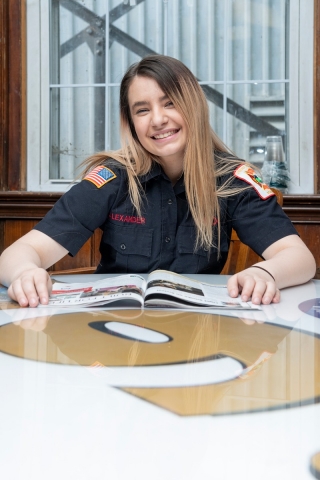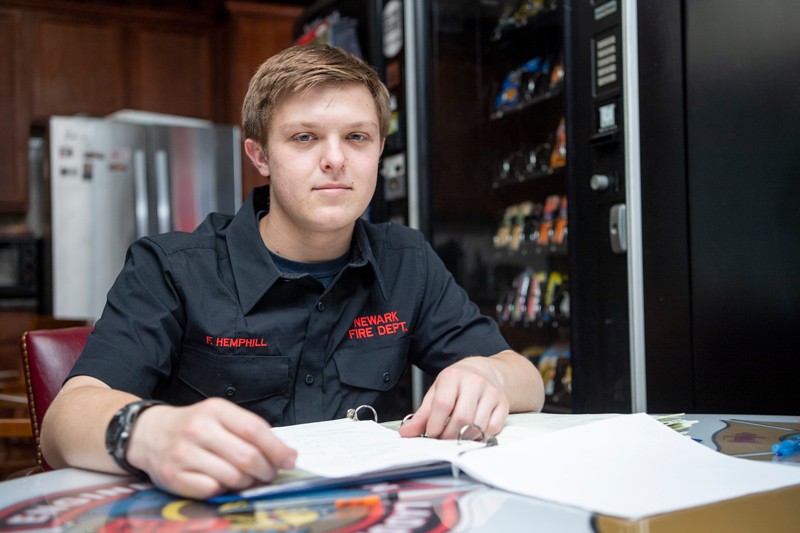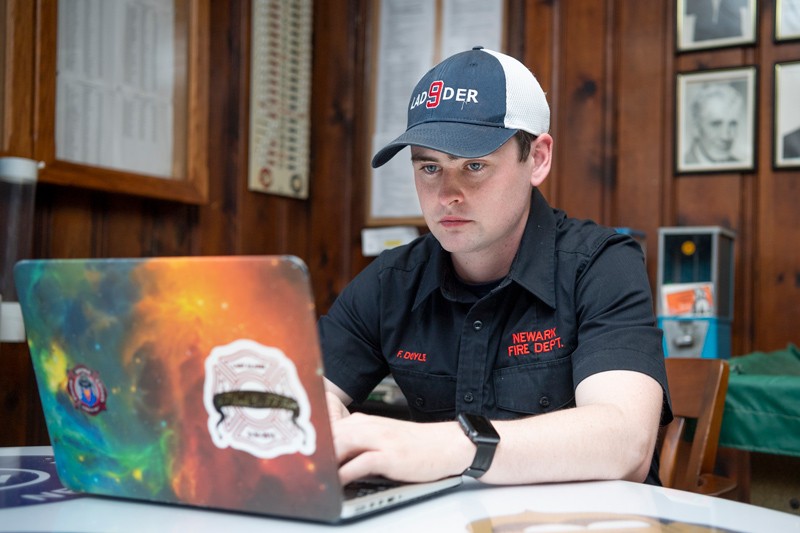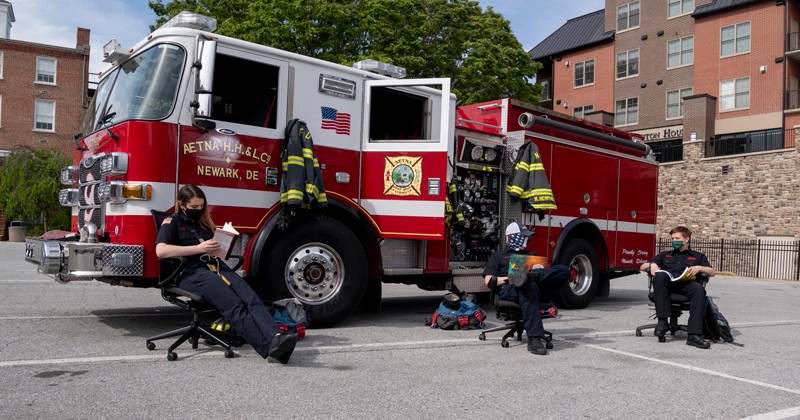After campus closed due to COVID-19, Blue Hens who work as volunteer firefighters stayed behind to serve their community
With college campuses closed during the coronavirus (Covid-19) pandemic, you might expect to find undergraduates mourning the loss of academic and social routine the same way a lot of Americans are coping — at home in a cozy pair of sweatpants with comfort food and the latest TV binge.
But — for one group of University of Delaware students — this is a time for heroism over Hulu.
Approximately 30 Blue Hens work or volunteer with the Aetna Hook, Hose and Ladder Company, one of the busiest fire companies in the state — first responders, who serve the Newark area, answered more than 12,000 calls last year. Six of these students take part in the live-in program, meaning they each volunteer about 36 hours per week as firefighters with Aetna’s Academy Street station in return for free housing. Some also put in additional, paid hours as emergency medical technicians, or EMTs. In March, when most of their peers left campus to ride out the quarantine period with loved ones, these undergraduates chose to stay behind and serve their community.
“They aren’t here for their resume,” said Brian Corbett, the live-in committee co-chair and a volunteer firefighter of 25 years. He is also the father of two Blue Hens not involved in the program. “These students genuinely want to help. They have great drive and great enthusiasm for life and learning. And, by supplementing our staffing, they are critical to the success of what we do.”

“The thing I like most about UD is definitely the sense of community,” said senior Blue Hen Olivia Alexander, who has been a volunteer firefighter since the age of 16. “Everyone wants to work together to help each other.”
The job has changed since the onset of the pandemic. Certain emergencies, like those necessitating CPR, now call for full-body protection in the form of disposable coveralls. And the ambulance disinfection process no longer happens on a case-by-case basis, but after every transport. It is also more time-consuming — what used to be a manual, 10-minute wipe-down now requires half an hour and a virus-killing spray gun filled with cleaning solution. But the biggest change for student volunteers might be the added layer of uncertainty each time an emergency vehicle pulls out of the station — even for routine calls.
“We are definitely stepping into the unknown,” said Olivia Alexander, an Aetna member and UD senior majoring in neuroscience. “Our dispatchers do their best to get us all the information possible, but you just never know what you’re walking into.”
Alexander, who counts among her inspirations an uncle who served the New York City Fire Department during 9-11, relayed a recent interaction with a local homeowner. His problem turned out to be a carbon monoxide leak — nothing too harrowing for emergency personnel during normal times — but the man’s constant coughing was understandably unsettling. (He tested negative for COVID-19.)
The longer this goes on, Alexander added, the harder it is to be away from family.
“I do miss them,” she said. “And — being from New York — I also miss the pizza.”
But serving with Aetna during a pandemic has its upsides, too, members will tell you. Take Michael Hemphill, an Honors sophomore mechanical engineering major who, prior to the outbreak, had been looking forward to a hands-on class project. He and his peers were set to use a high-tech robotic arm, a six-axis computer-numerical-control router, to manufacture a plate they designed to aid in the repair of a fractured human bone. When classes were moved online due to COVID-19, the task was put on hold. But, Hemphill explained, volunteering has tempered the sting of disappointment: “Helping someone out just makes you feel better.”

Michael Hemphill, a sophomore at UD, explained that he and fellow students who volunteer as firefighters have been staying away from loved ones during the COVID-19 crisis, just in case they pick up the virus during a shift. “We’re lucky to be able to do so,” he said. “Because of the special housing agreement we have, we don’t risk bringing anything home to our families.”
The Newark native, a firefighter and registered EMT, said he’s seen an uptick in medical calls since the start of the pandemic — not just from those experiencing coronavirus symptoms, but from those experiencing anxiety attacks due to the ongoing stress of collective trauma. Easing the panic of strangers — encouraging them to focus on their breath and recall basic facts to focus the mind — has made it easier to keep his own cool during a trying period.
“It definitely helps,” he said. “If you’re not calm, there’s no way they’re going to be, so you have no choice. You can’t freak out.”
In their years of service, Aetna volunteers have confronted intense situations. Alexander worked a seven-alarm fire in 2018 at the landmark Willey Farms marketplace in Townsend, Delaware, which drew emergency workers from four states. Hemphill said he’s responded to fatal car accidents and more CPR calls than he can count. And Marc Doyle, a fifth-year student studying organizational and community leadership, described the adrenaline rush of being inside a maintenance facility while it burned, not being able to see his own hand in front of his face — “There weren’t any windows,” he said. “So there was nowhere for the smoke to go.” But ask the student volunteers for their most memorable experiences, and they will point to smaller, daily interactions with the community — interactions that have taken on new meaning since the onset of COVID-19.

“I want to be there for the community,” said Marc Doyle, fifth-year student at UD and volunteer firefighter. “I do enjoy helping people — that’s part of it. But I also just enjoy the work. Being able to do this every day with my friends? It’s like being part of a really upstanding fraternity.”
“Whether it’s helping a cat out of a tree or untangling an American flag, every call is helping someone in some way,” Doyle said. “We’ve had people who are lonely, and all they want is an emergency responder to come by and help with their chair or put a pillow under their neck. These aren’t life-or-death situations, and we try not to make a big deal of it because this type of thing can be a drain on emergency resources — we try to determine a better, long-term solution for these people. But it’s also rewarding when you can do something simple that makes a big difference in someone’s day.”
The efforts have not gone unnoticed. The students, who describe their fellow volunteers as a second family, said they’ve seen an increase in expressions of gratitude from community members since the start of the pandemic. In some cases, adults and young children have stepped outside to wave as fire trucks and ambulances drive by, heartened by the reminder that, even when things are tough, there are people stepping up to help.
“I feel like we’re a symbol of hope in the community,” Alexander said.
And, yes, she added, this more than makes up for a lack of TV time and takeout — even New York pizza.
| Photos by Kathy F. Atkinson


